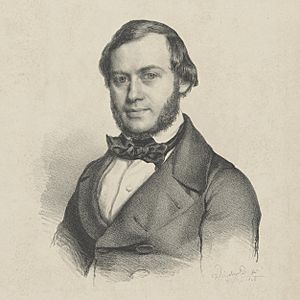Ferdinand David (musician) facts for kids
Ferdinand David (born June 19, 1810 – died July 18, 1873) was a famous German virtuoso violinist and composer. A virtuoso is someone who is incredibly skilled at playing a musical instrument. Ferdinand David was known for his amazing violin playing and for writing many pieces of music.
Contents
Biography
Ferdinand David was born in Hamburg, Germany. He was born in the same house where another famous composer, Felix Mendelssohn, had been born just one year earlier. David grew up in a Jewish family but later became a Protestant Christian.
From 1823 to 1824, David studied music with important teachers like Louis Spohr. In 1826, he became a violinist at the Königstädtischen Theater in Berlin. Later, in 1829, he was the main violinist for a string quartet in a place called Dorpat (now Tartu, Estonia). He also traveled to cities like Riga, Saint Petersburg, and Moscow to perform concerts.
In 1835, David became the Konzertmeister (or concertmaster) at the Gewandhaus in Leipzig. This was a very important job, and he worked closely with Felix Mendelssohn there. A concertmaster is the leader of the first violin section in an orchestra and often helps the conductor. David even married Sophie, the daughter of Baron Carl Gotthard von Liphardt, who was his employer in Dorpat.
In 1843, David became the first violin teacher at the new Leipziger Konservatorium für Musik, which is a music school. He helped Mendelssohn a lot when Mendelssohn was writing his famous Violin Concerto in E minor. David was even the first person to perform this concerto in 1845. He also played the first official performance of Clara Schumann's first violin sonata in 1852, along with Clara Schumann herself.
After Mendelssohn passed away suddenly, Ferdinand David took on the role of Kapellmeister for the Gewandhaus Orchestra. A Kapellmeister is the leader of an orchestra or choir. He held this position from 1841–1842 and again from 1852–1854.
Ferdinand David died suddenly in 1873, when he was 63 years old. He was on a mountain trip with his children near Klosters in Switzerland.
Musical Compositions
Ferdinand David wrote about 50 musical pieces. These include 12 "theme and variations" pieces for violin and orchestra, and five violin concertos. He also wrote music for other instruments, like concertinos for violin, bassoon, clarinet, and trombone with an orchestra. A concertino is a short concerto. He also wrote a number of lieder, which are German songs.
His most famous piece today is his Concertino for Trombone and Orchestra, Op. 4. This piece is often played by trombonists when they try out for symphony orchestras around the world.
Editing and Arranging Music
Ferdinand David worked closely with music publishers in Leipzig, like Breitkopf & Härtel. He also edited music for violin by other composers, such as Francesco Maria Veracini and Pietro Locatelli. Editing music means preparing it for publication, making sure it's correct and clear.
He also edited the complete Beethoven piano trios for C.F. Peters Edition. In 1843, he edited J.S. Bach's Sonatas and Partitas for solo violin.
David also made an arrangement of Niccolò Paganini's famous 24 Caprices for Solo Violin for violin and piano. An arrangement means changing a piece of music so it can be played by different instruments or in a different way. This version was used for the first complete recording of the Caprices in 1940.
He also wrote a well-known version of the cadenza for Beethoven's violin concerto. A cadenza is a part of a concerto where the soloist plays alone, often showing off their skills. This cadenza was used by 12-year-old Joseph Joachim in 1844 when the piece was performed again under Mendelssohn.
Other Interesting Facts
Ferdinand David played on a very special violin made in 1742 by a famous maker named Guarneri. This violin later became the main instrument for another famous violinist, Jascha Heifetz. Today, the "David Guarneri" violin is in a museum collection in San Francisco and is loaned to Alexander Barantschik, who plays it with the San Francisco Symphony.
Ferdinand David's son, Paul David, became the first Director of Music at Uppingham School in England, from 1864 to 1908.
In 1835, when Mendelssohn became the Kapellmeister of the Gewandhaus Orchestra, there was an audition for the Konzertmeister position. Another famous violinist, Karol Lipiński, also tried out. It is thought that David's friendship with Mendelssohn from childhood might have helped Mendelssohn choose David for the job.
See also
 In Spanish: Ferdinand David para niños
In Spanish: Ferdinand David para niños


